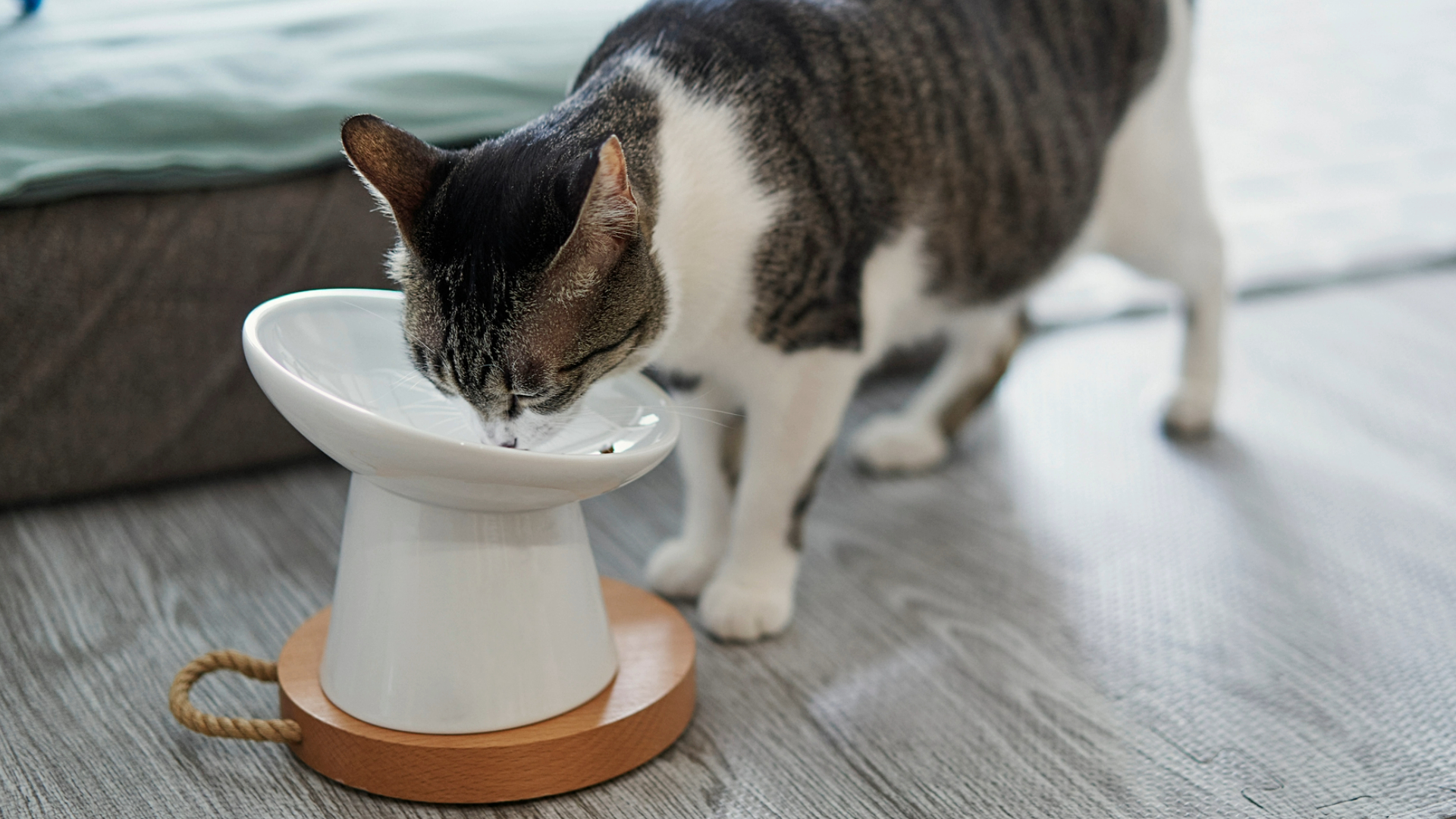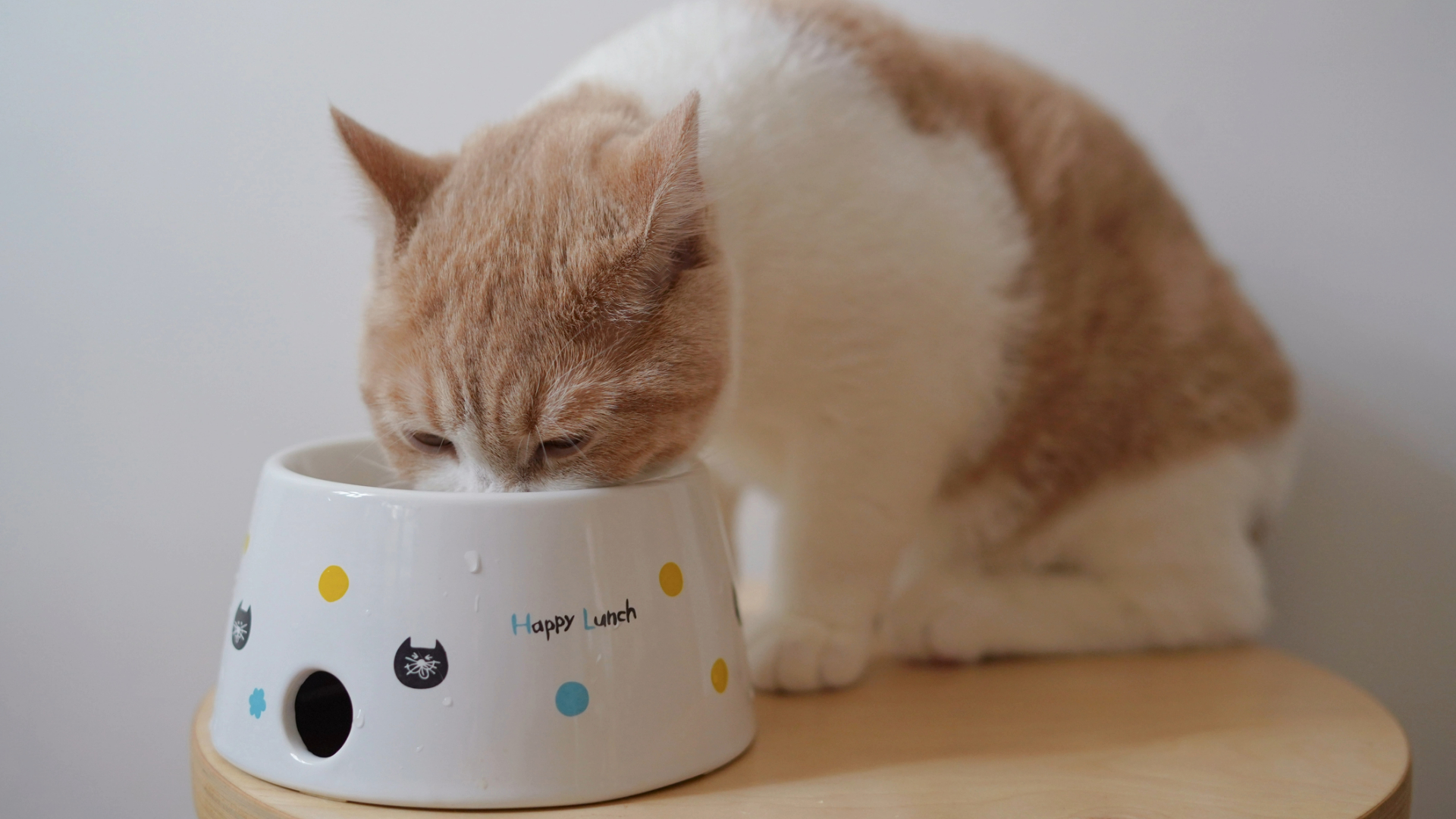Should I elevate my cat’s food bowl? Here’s what a vet has to say
Should I elevate my cat’s food bowl? A vet explains the benefits and how to choose the right one for your feline friend.

You might be wondering, ‘Should I elevate my cat’s food bowl?’ There’s a lot of debate over whether a raised bowl is better for your pets’ digestive health (as opposed to a standard one that sits flat on the floor) but is it really all it’s cracked up to be? We spoke to a vet to find out.
You might have bought your kitty the very best cat food, but have you thought about the bowl they’re eating from? If you’ve never considered an elevated option before, then it might be worth giving it a go and seeing if it’s right for your cat.
These feeders are also known as anti-vomit bowls as manufacturers claim that they decrease the chances of vomiting and indigestion. They also claim to make your cat’s eating experience more comfortable by reducing the strain on their neck and the stress on their joints.
This is particularly helpful for arthritis in cats - a condition that causes stiff muscles and sore joints. If your feline has whisker fatigue, then you might also want to invest in one of the best anti-vomit bowls for cats.
We asked vet Dr. Catherine Barnette to explain the benefits of an elevated cat bowl, whether it’s worth buying, and her tips for choosing the best one for your furry friend. Here’s everything you need to know:

Dr. Barnette graduated from the University of Florida in 2006 where she received both her B.S. in Zoology and her Doctor of Veterinary Medicine (DVM). She has 15 years of clinical experience as a small animal veterinarian, treating dogs, cats, and occasional exotic patients. When she’s not writing content as a freelance veterinary writer, Dr. Barnette lives in southwest Florida with her husband and daughter (plus two cats, a dog, and a rescued dove!) and enjoys kayaking, biking, and hiking.
Benefits of a raised cat bowl
The companies that manufacture and market elevated cat bowls suggest a number of possible benefits that can be associated with these bowls. Depending on the manufacturer and advertiser, these bowls are purported to be more comfortable for cats to use, while also decreasing the likelihood of vomiting and indigestion. Unfortunately, however, there is no evidence to validate these claims.
At this time, there have been no scientific studies to determine whether cats are more comfortable eating from a traditional floor-level bowl or an elevated cat bowl. Like many aspects of pet ownership, the best cat food bowl likely depends on that particular cat’s personality and preferences. Some cats may prefer an elevated cat bowl, while others prefer a traditional floor-level bowl. The only way to determine which style of bowl is more comfortable for your cat is to offer both options and see which style of bowl your cat gravitates towards.
Get the best advice, tips and top tech for your beloved Pets
An elevated cat bowl should never be regarded as treatment for gastrointestinal issues in cats. Vomiting and indigestion in cats almost always has an underlying medical cause, which means that your cat needs a thorough veterinary workup and treatment. Your vet may ultimately recommend a change in your cat’s food bowl to address your cat’s gastrointestinal condition, but this determination should only be made after a thorough diagnostic workup and is often combined with other treatments or dietary modifications.

Which cats may benefit from an elevated bowl?
While an elevated bowl is not expected to be beneficial for every cat, there are certain circumstances in which your vet may recommend an elevated cat bowl.
Cats with megaesophagus may benefit from an elevated bowl. Megaesophagus is a medical condition in which the esophagus does not function normally. In affected cats, the lack of appropriate muscle contractions in the esophagus limits the cat’s ability to move from the mouth to the stomach.
Cats with megaesophagus may regurgitate undigested food shortly after eating, because their food does not travel down the esophagus in a normal manner. Cats with megaesophagus may benefit from an elevated bowl, due to the effects of gravity. When a cat with megaesophagus eats from an elevated bowl, the esophagus no longer has to move food uphill towards the stomach, as it would when a cat is eating off the ground, hunched over their food. The use of an elevated bowl allows gravity to assist in moving food from the mouth to the stomach.
Cats with other eating or swallowing problems may also benefit from an elevated food bowl. Whether your cat has severe dental disease, a neurologic issue, or even a severe upper respiratory infection that makes swallowing difficult, an elevated food bowl can help by overcoming the resistance of gravity, making it easier to take food into the mouth and swallow the food.
Finally, some cats with mobility issues benefit from an elevated bowl. If your cat has arthritis in her forelimbs or severe neck pain, bending down to eat from a food bowl on the floor may be a bit of a challenge. Through trial and error, you can experiment with different bowl heights and determine whether an elevated cat food bowl may be more comfortable for your cat.

How to choose the best elevated cat bowl
In most cases, choosing the best elevated cat bowl will involve a bit of trial and error. If your cat has a specific medical condition, such as megaesophagus, your vet may provide you with general guidelines for what to look for in the height of a bowl and other factors that may also help your cat receive the maximum possible benefits from her elevated bowl.
If your cat has difficulty chewing or mobility limitations, you may need to experiment in order to determine the best bowl to overcome those issues. Consider both the height of the bowl and the diameter of the bowl when selecting a bowl that will be comfortable for your cat. You may need to try a few different bowls before finding the ideal option for your cat.
Also, pay attention to the material that was used to make the bowl. In general, glass, ceramic, or stainless steel bowls are preferred, because they are easier to sanitize. Plastic bowls often develop tiny scratches in their surface over time, which can result in these bowls being difficult to thoroughly disinfect.
Pets So Good Oreo Table Dog & Cat Bowls
If you’re on the hunt for an elevated cat bowl, then this one is a great option. It comes in two different sizes and promises to help relieve neck and back pain. Plus, the ultra-modern design will look great in your home and comes in various colors to match your aesthetic.
Elevated bowls may come as individual bowls or in a combined bowl stand that holds both a food and water bowl. Again, this is an issue where you may want to experiment. Many cats do well with paired food and water bowls. However, if your cat is a messy eater, paired bowls could result in your cat’s water becoming contaminated with food particles more frequently.
In general, you should clean your cat’s food and water bowl once daily (or after every meal if you are feeding canned food). Food bowls can become contaminated with bacteria if not washed, potentially posing a health risk to both you and your cat. Bowls can be hand-washed in hot, soapy water. Additionally, many bowls are dishwasher-safe and can be washed in your dishwasher. When choosing your cat’s food and water bowls, pay attention to how easy the bowls will be to clean on a regular basis.
Unless your cat has a specific medical condition, such as megaesophagus or a musculoskeletal disorder, the answer to the question “should I elevate my cat’s food bowl?” is usually “maybe, if your cat prefers it.” Despite what you may see on television commercials, there is no medical reason to feed most cats out of an elevated bowl. However, if your cat prefers to use an elevated bowl, there’s also no harm in doing so! Experiment with a variety of food and water bowls to determine which type of bowl your cat prefers.

Worried about your cat not eating or cat eating too fast? Then be sure to check out our guide where an expert vet runs you through the most common causes and what to do.
Dr. Barnette is a graduate of the University of Florida, where she received both her B.S. in Zoology and her Doctor of Veterinary Medicine (DVM). She has 15 years of clinical experience as a small animal veterinarian, treating dogs, cats, and occasional exotic patients. She now works as a freelance veterinary writer, creating educational content for veterinarians, veterinary team members, and dedicated pet owners. Dr. Barnette lives in southwest Florida with her husband and daughter (plus two cats, a dog, and a rescued dove!) and enjoys kayaking, biking, and hiking. Learn more about Dr. Barnette at www.linkedin.com/in/catherinebarnette.


